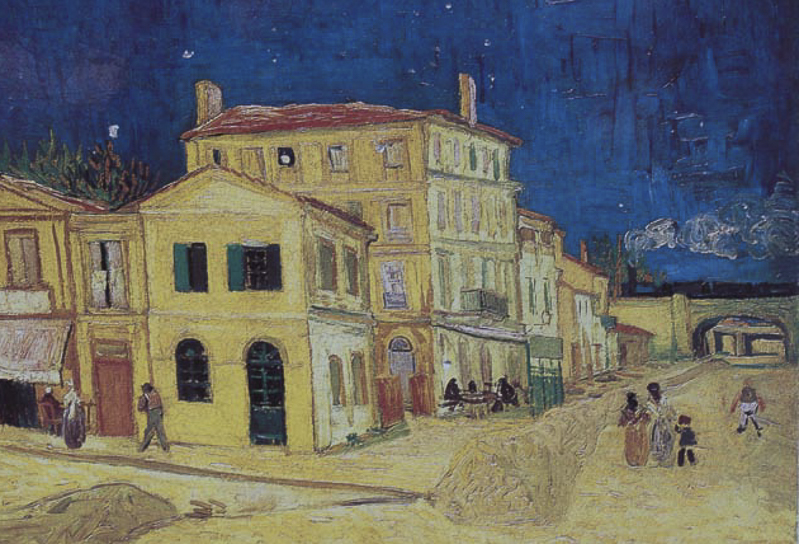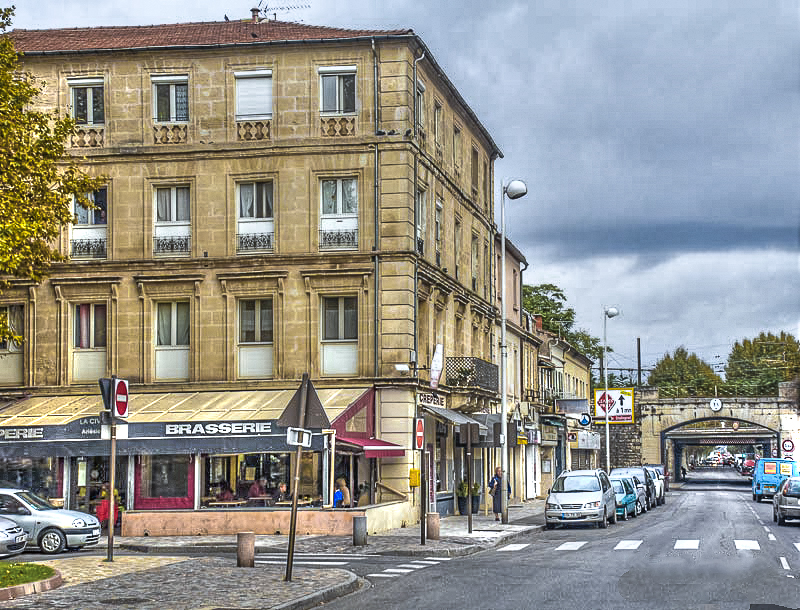In May 1888 Vincent Van Gogh rented four rooms at 2 Place Lamartine, in a town called Arles in the south of France. This would come to be known as the Yellow House. The rooms were on the right wing of the nearest building in the painting. The two ground floor rooms were used for a studio and a kitchen. The upstairs corner room was the guest room for Gauguin, while the one next to it (with one shutter closed) was Van Gogh’s bedroom – the one later painted with the chair and pipe. At a later point, he rented two more rooms upstairs at the back of the house. On 16 September 1888 Vincent wrote to his sister Wilhelmina describing the house, and his contentment at finding a place where he felt he could think and paint:
“My house here is painted the yellow colour of fresh butter outside with raw green shutters; it stands in the full sunlight on a square which has a green garden with plane trees, oleanders and acacias. And it is completely whitewashed inside, and the floor is made of red bricks. And over it the intensely blue sky. There I can live and breathe, think and paint.”
– Letter Vincent Van Gogh to his sister Wilhelmina dated 16 Sept 1888 letter W07

The painting was done in September 1888 and was originally called The Street – we were there in October a couple of years ago and found the light similar to that discovered by Van Gogh. I could see why the place attracted him – for the light and the colours – and especially the sky which is emphasised by the brightly painted buildings of the town.
Van Gogh wrote to his brother Theo on 28 September, about this painting among others:
“…Also a sketch of a 30 square canvas representing the house and its setting under a sulphur sun under a pure cobalt sky. The theme is a hard one! But that is exactly why I want to conquer it. Because it is fantastic, these yellow houses in the sun and also the incomparable freshness of the blue. All the ground is yellow too. I will soon send you a better drawing of it than this sketch out of my head.
The house on the left is pink with green shutters. It’s the one that is shaded by a tree. This is the restaurant where I go to dine every day. My friend the factor is at the end of the street on the left, between the two bridges of the railroad. The night café that I painted is not in the picture, it is on the left of the restaurant.”
When he wrote the letter, Vincent was 35 years old, and was eagerly awaiting the arrival of Paul Gauguin. Gauguin would live at the house for nine weeks from the end of October 1888. The night cafe is actually across the Place Lamartine, through the Town Gate and up the street on the square where the Roman Forum once stood.
The square is still there – complete with its plane trees and oleanders, but the house was badly damaged when it was accidentally bombed by the Allies on 25 June 1944 as they were targeting the railway bridge across the Rhône during the liberation of Arles – and the house was demolished shortly afterwards. Nevertheless, the four-storey building behind survives to this day, along with the railway bridges in the background. The bridges are easily recognised from Van Gogh’s depiction of them. The nearer bridge (with the steam train depicted in Van Gogh’s painting) is for the local line, while the further bridge (with square supports) is for the Paris and Lyon lines. The street running through beneath the bridges is Rue Montmajour.
Van Gogh’s observation and drafting skills are evident in his painting – the two railway bridges are easily identifiable today, as is the building that stood behind the Yellow House. The inclusion of a train on the bridge also evokes the message of his desire for Gauguin to visit, and to suggest that the railway network kept him connected with his brother Theo, as well as to the rest of the Paris art scene. Trains at that point in history were symbols of modernity and progress, and showed how the world was shrinking and becoming more intertwined. Arles was no longer a distant outpost, but part of a networked France.

The house was just two minutes’ walk from the site where he painted the ‘Starry Night over the Rhone’. Today, if you turn around from where this photo was taken you will find a modern ‘Monoprix’ supermarket and a roundabout (formerly a park) – so if you are looking for the location, just look for the Monoprix first and it is just across the intersection.
By looking at a place through the eyes of a painter almost 130 years ago, we can see the changes and continuities in the landscape, and gain a sense of the presence of history wherever we travel. And in the process, perhaps we can begin to develop a language of seeing and a way of thinking about the cultures we encounter and how this, in turn, says something to us about our own culture.
The Yellow House painting currently hangs in the Van Gogh Museum in Amsterdam.

Very timely as I just watched the doco China’s Van Goghs on the flight back from Brisbane (highly recommended). The Chinese artists visited Arles and went to the cafe etc. So I recalled out talking about your visit there.
Thanks Leonie – in fact I was prompted to go and watch the movie ‘Loving Vincent’ – every frame of teh full-length movie was hand painted by over 100 artists trained to paint in Van Gogh’s style. Absolutely brilliant if you get the chance to see it, it’s very worthwhile!
Lovely little story. Thankyou for your perspective. One of our favourite places in the world….it will be great to check out these places with this info in mind.
Thanks Veronica – yes it’s a fascinating and wonderful place to visit 🙂